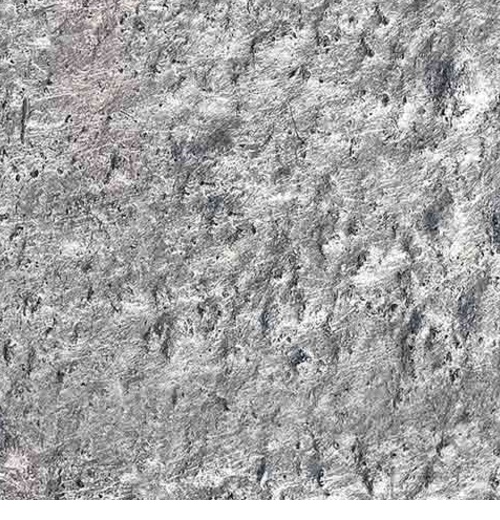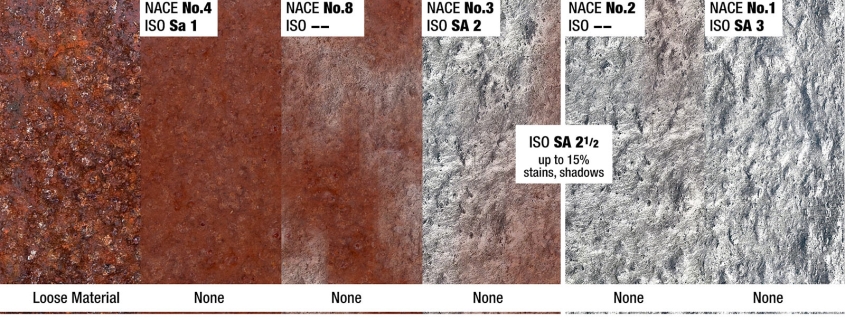Pipeline Protective Coatings: Surface Preparation Standards
Introduction
Surface preparation is critical in industries like oil and gas, marine, and infrastructure to ensure that protective coatings adhere correctly and perform well over time. Several international standards govern the level of surface cleanliness required before applying coatings. This blog focuses on the commonly referenced Surface Preparation Standards: ISO 8501-1 Sa 2½, SSPC-SP 10, NACE No. 2, and SIS 05 59 00 Sa 2½.
1. ISO 8501-1 Sa 2½: Surface Preparation Standards
Objective:
ISO 8501-1 is an internationally recognized standard that specifies the degrees of cleanliness for steel surfaces after blast cleaning. Sa 2½ refers to a comprehensive blast cleaning that removes nearly all rust, mill scale, and old coatings, leaving only slight shadows or discolorations.
Key Aspects:
Surface Appearance: The surface should be free of mill scale, rust, and old coatings, with only slight residues of stains or discoloration from rust or mill scale remaining. At least 95% of the surface area should be free of visible contaminants.
Visual Standard: ISO 8501-1 Sa 2½ provides visual examples of acceptable cleanliness levels, allowing inspectors to compare the prepared surface against these references to ensure compliance.
2. SSPC-SP 10: Near-White Metal Blast Cleaning
Objective:
SSPC-SP 10, also known as near-white metal blast cleaning, is a standard that specifies the level of surface cleanliness required for steel surfaces before coating. It aims to remove nearly all visible contaminants, leaving a surface with only slight staining.
Key Aspects:
Surface Cleanliness: At least 95% of each unit area should be free of all visible oil, grease, dust, dirt, mill scale, rust, coating, oxides, corrosion products, and other foreign matter. The remaining 5% may contain slight discoloration but no significant deposits.
Surface Profile: SSPC-SP 10 requires the surface profile to be rough enough to ensure good coating adhesion, typically achieved through abrasive blasting.
3. NACE No. 2: Near-White Metal Blast Cleaning
Objective:
NACE No. 2 is the equivalent of SSPC-SP 10 and describes the same near-white metal blast cleaning level. It is widely used in industries where the corrosion resistance is critical.
Key Aspects:
Surface Appearance: Similar to SSPC-SP 10, NACE No. 2 specifies that at least 95% of the surface should be free of visible contaminants, with only light staining allowed in the remaining 5%.
Equivalency: NACE No. 2 is often used interchangeably with SSPC-SP 10, as they describe near-white metal blast cleaning with minimal residual staining or discoloration.
4. SIS 05 59 00 Sa 2½: Very Thorough Blast Cleaning
Objective:
SIS 05 59 00 Sa 2½ is a Swedish standard describing a thorough blast cleaning process. Like ISO 8501-1 Sa 2½, this standard requires a high level of cleanliness with minimal visible staining or discoloration.
Key Aspects:
Surface Appearance: The steel surface should be free from mill scale, rust, and previous coatings, with only slight residues of rust or mill scale visible in no more than 5% of the surface area.
Usage: SIS 05 59 00 Sa 2½ is widely recognized and used, particularly in Europe and Asia, and is considered equivalent to ISO 8501-1 Sa 2½, SSPC-SP 10, and NACE No. 2.
Comparing the Standards
All four standards—ISO 8501-1 Sa 2½, SSPC-SP 10, NACE No. 2, and SIS 05 59 00 Sa 2½—describe nearly equivalent levels of surface preparation:
Surface Cleanliness: Each standard requires that at least 95% of the surface area be free from visible contaminants like rust, mill scale, and old coatings. The remaining 5% can contain only slight staining or discoloration, which should not affect the coating’s performance.
Surface Profile: While the exact surface profile is not specified in these standards, it is generally accepted that a roughened surface is necessary to ensure proper coating adhesion. The profile is typically achieved through abrasive blasting.
Visual Comparators: Each standard provides visual comparators to assess the level of cleanliness, helping inspectors and contractors ensure that the surface meets the required criteria.
Near White Blast Cleaning (SP 10 / Nace #2 / Sa 2.5)

Loosely adhering material: 0%
Tightly adhering material: 0%
Stains, streaks, shadows: SP 10 5%, Sa 2 ½ 15%
Near White Blast Cleaning specifies that shadows, streaks, and stains must be limited to 5% of the surface area. Near White is selected when the added benefit of blasting to White Metal doesn’t justify the added expense.
Near White is typically specified for high-performance coatings over steel exposed to severe environmental conditions, such as chemical spills and fumes, high humidity, and proximity to salt water. It is commonly specified for off-shore platforms, shipyards, and other marine environments.
Practical Implications
Understanding these standards is essential for ensuring the longevity and effectiveness of protective coatings, especially in environments prone to corrosion:
Coating Performance: Proper surface preparation as specified by these standards ensures that coatings adhere well, reducing the risk of premature failure due to poor adhesion or residual contaminants.
Global Applicability: Knowing the equivalence of these standards allows for flexibility in meeting international project specifications, ensuring that contractors and suppliers are aligned on the required level of surface cleanliness.
Quality Control: Adhering to these standards provides a benchmark for quality control, ensuring that surface preparation is consistent and reliable across different projects and environments.
Conclusion
ISO 8501-1 Sa 2½, SSPC-SP 10, NACE No. 2, and SIS 05 59 00 Sa 2½ are critical Surface Preparation Standards in the surface preparation industry. Each defines a similar level of cleanliness required before coating application. Understanding and applying these standards ensures that steel surfaces are correctly prepared, leading to better coating performance and longer-lasting protection against corrosion.




